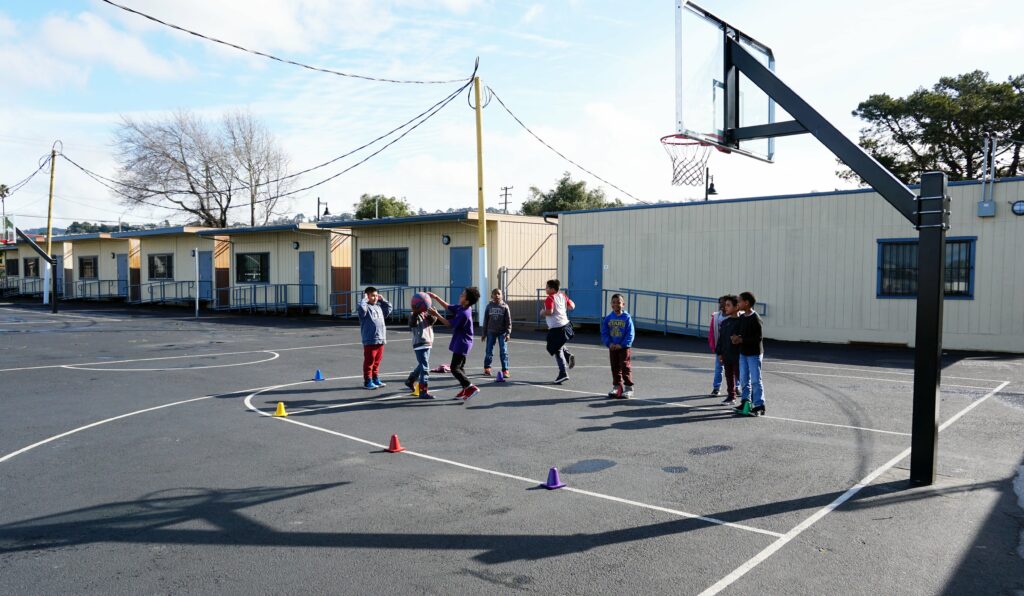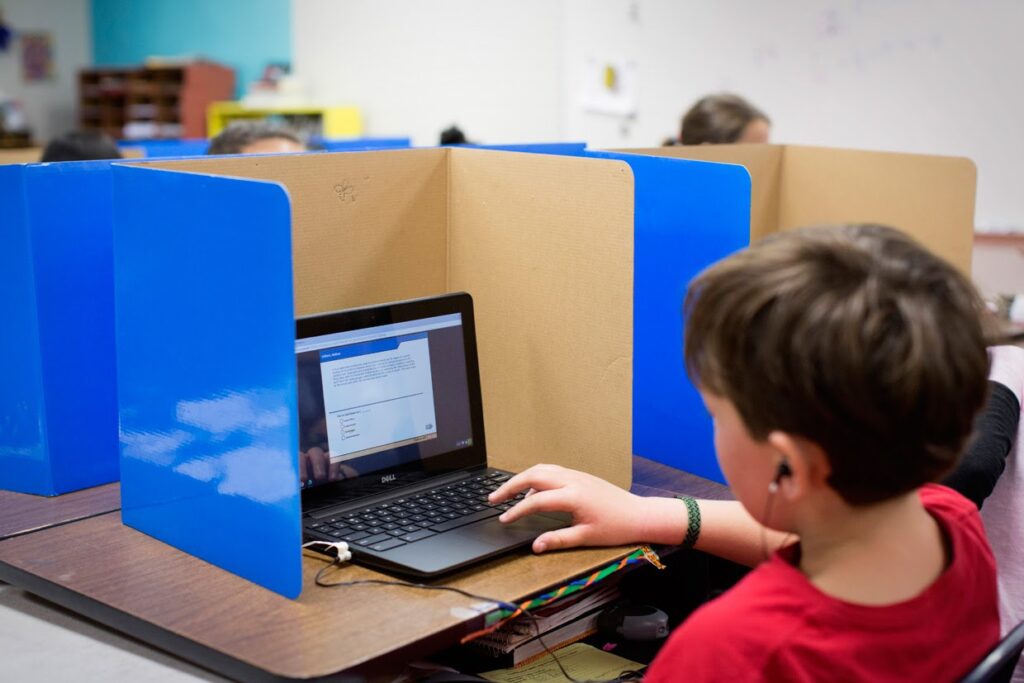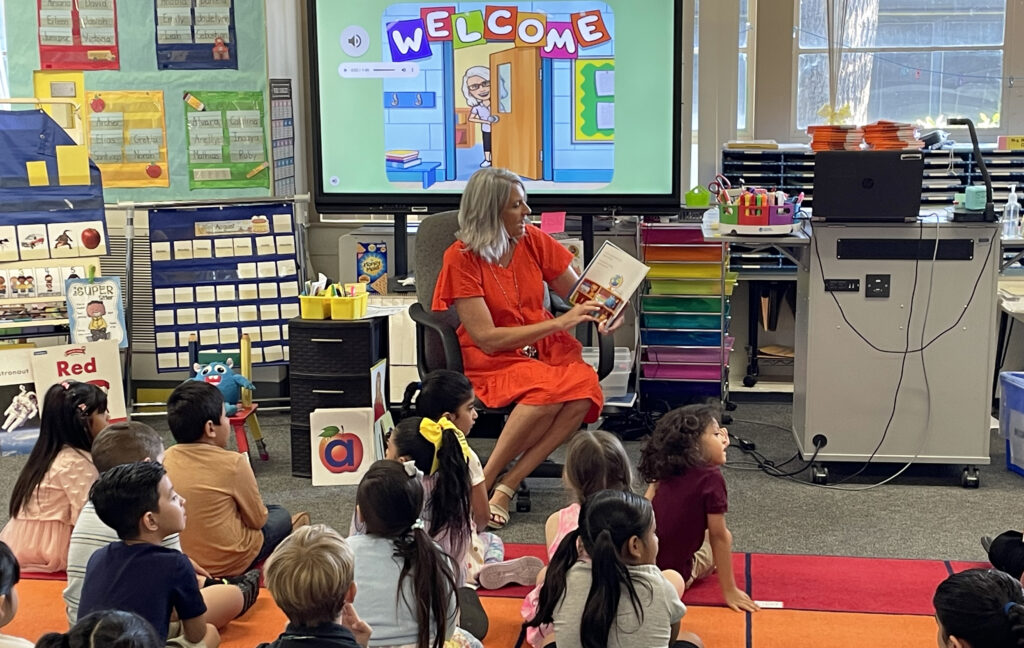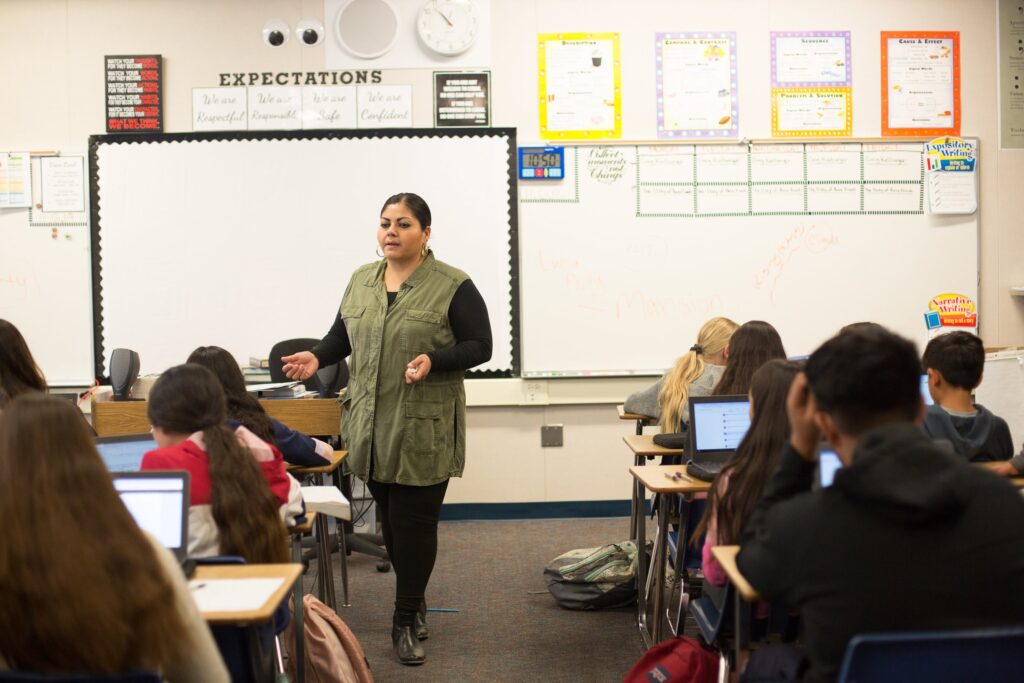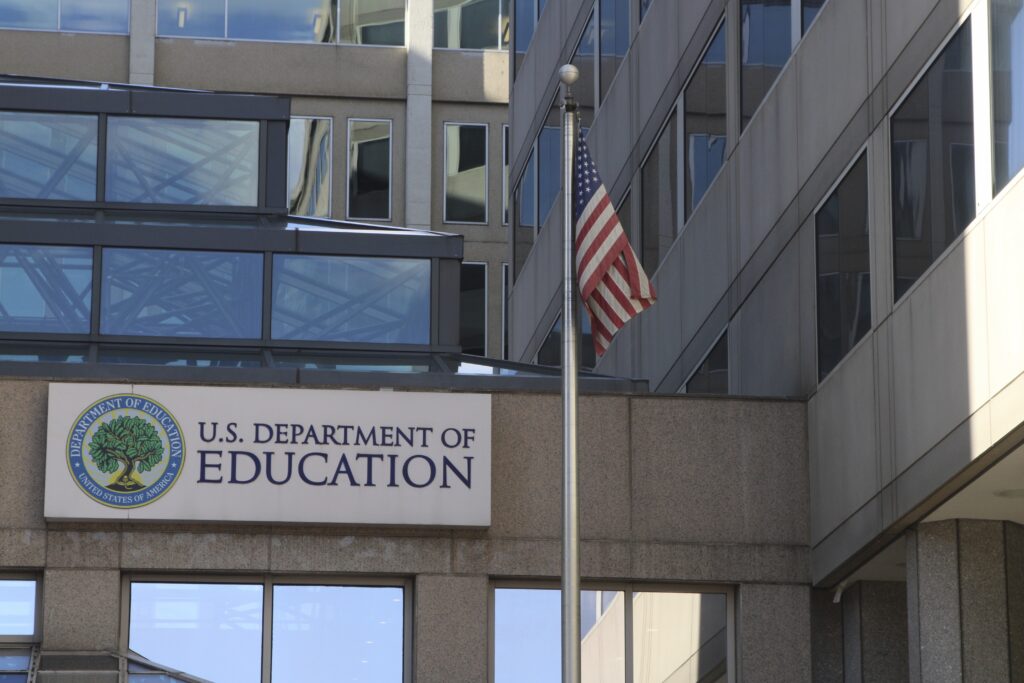
West Contra Costa Unified’s Stege Elementary School in Richmond.
Credit: Andrew Reed / EdSource
More than 1 in 4 school districts are asking local voters to approve a record $39 billion in school construction bonds on the Nov. 5 ballot. Those that pass will jockey for some of the $10 billion in matching state funding that Gov. Gavin Newsom and the Legislature are asking voters to approve by passing Proposition 2.
The facility needs of districts are huge and growing, even as the state’s overall enrollment is projected to decline over the next two decades.
Decades-old “portable” classrooms are falling apart; many air conditioners are malfunctioning, and classrooms without them are sweltering. Roofs leak, plumbing is corroding, wiring is fraying.
Parents worry about open access to insecure campuses. Schools lack room for new transitional kindergarten classes and plans for climate-resilient, energy-efficient buildings. Increasingly popular career and vocational education programs need up-to-date spaces.
Districts’ priorities will vary, and so will their capacity to pay for them. As in the past, districts with high property values, which often correlate to higher-than-average incomes of homeowners, will have a leg up on their property-poor neighbors in terms of what they can ask their taxpayers to approve. Some districts will check off items on their wish list; other districts will resort to triage, fixing what’s most falling apart.
In March 2020, amid first reports of a new pandemic on the horizon, statewide voters defeated a state construction bond with an unlucky ballot number. As a result, the state fell further behind in helping districts repair and rebuild school facilities.
“The defeat of Proposition 13 in 2020 and the pandemic made local districts more hesitant to put bonds on the ballot in 2022, so there is a lot of pent-up need,” said Sara Hinkley, California program manager for the Center for Cities + Schools at UC Berkeley, which has extensively analyzed facilities needs in the state.
“The number of bond measures and the total amount reflect the aging and deferred maintenance of California schools, as well as the increasing urgency of HVAC and schoolyard upgrades to grapple with extreme heat.”
The center estimates that 85% of classrooms in California are more than 25 years old; 30% are between 50 and 70 years old, and about 10% are 70 years old or older.
Proposition 2 won’t significantly reform a first-come, first-served funding system if it passes, but it will clear out a backlog of unfunded school projects and partially replenish a state-building fund that has run dry.
With so much on the ballot competing for attention, Proposition 2 may escape many voters’ attention. Here are answers to questions that should help you fill out your ballot.
What’s on the ballot this year?
School districts have placed 252 bond proposals to raise $39.3 billion; 15 community college districts are asking voters to pass $10.6 billion worth of bonds, for a total of 267 proposed bonds valued at $49.9 billion. They range from a proposed $9 billion bond issue in Los Angeles, the state’s largest district, to $3 million sought by Pleasant View Elementary School District for repairs to its only school in Porterville.
How is school construction funded?
Unlike school districts’ operating money, which mostly comes from the state’s general fund, school construction and repairs remain largely a local responsibility, paid for by bonds funded by property taxes. Over the past 20 years, voters approved $181 billion in local bonds for public school and community college facility projects, according to the Legislative Analyst’s Office.
That compares with $31.8 billion over the same period in state facilities bonds passed for school district and community college construction, plus $4.6 billion from the general fund that Gov. Gavin Newsom directed toward school construction. Altogether, the state has chosen to bear only 17% — one-sixth — of the total costs of school construction since 2001.
Bonds are essentially loans that are paid back, commonly over 25 or 30 years, with interest. In the past 10 years, interest rates have ranged from about 2% to nearly 5% and now are coming down again. The Legislative Analyst’s Office estimates it would cost the general fund about $500 million annually for 35 years to pay back Proposition 2’s principal and interest.
What does it take to pass a bond?
The passage of a local bond requires a 55% approval rate. Despite the higher threshold than a simple majority, voters have approved 80% of local bonds on the ballot since 2001, according to CaliforniaFinance.com. The exception was in 2020, when voters defeated about half of local bonds, along with Proposition 13. The passage rate bounced back in 2022 to 72% — perhaps a good omen for proposals on Nov. 5 .
It takes only a 50% majority to pass a state construction bond. A voter survey in September by the Public Policy Institute of California found that 54% of likely voters said they would vote yes on Proposition 2, with 44% voting no.
The bulk of state funding for school and community college construction came in the early 2000s, during fast-growing enrollment and boom years for the state economy. However, the state issued no state bonds for a decade after 2006. The 2016 bond, Proposition 51, the last that voters approved, allocated $7 billion for K-12 and $2 billion for the state’s 115 community colleges. All of that funding has been distributed.
Are there limits to how much districts can tax property owners for school bonds?
Yes. Property taxes from school construction are capped at $60 per $100,000 of assessed valuation for unified districts, $30 per $100,000 for elementary or high school districts, and $25 per $100,000 for community college districts. A person whose home assessed value is at $400,000 (often significantly less than the market value) could pay up to $240 in annual property taxes in a unified district to pay off bonds’ principal and interest. Districts will stretch out the timeline for projects to stay under the limit.
How will Proposition 2 be divvied up?
The $10 billion will split:
- $1.5 billion for community colleges
- $8.5 billion for TK-12 districts, allocated as follows:
- $4 billion for repairs, replacement of portables at least 20 years old, and other modernization work
- $3.3 billion for new construction
- $600 million for facilities for career and technical education programs
- $600 million for facilities for charter schools
- $115 million set aside to remove lead in school water
Will all of this money go toward new projects?
No.
Unfunded projects left over from Prop. 51 in 2016 that are deemed eligible for funding will go to the front of the line. That’s how the system worked in the past when there wasn’t enough money to go around, and the Legislature applied the same language to Prop. 2. The rationale is that districts spent time and money hiring architects and engineers and drawing up plans, and shouldn’t be penalized for efforts done in good faith.
Those existing projects could consume half of the $8.5 billion for TK-12 funding. As of Aug. 31, the Office of Public Instruction, which tracks projects for funding, reported 1,000 school projects requesting $3.9 billion were already in line, with requests dating back to 2022. These break down to 812 modernization projects potentially eligible for $2.6 billion and 189 new construction projects eligible for $1.3 billion. The deadline for school districts to apply is Oct. 31, so the list may yet grow.
The Office of Public Construction cautioned that although the districts have filed paperwork, they have not been evaluated and approved for funding by the State Allocation Board under the rules in effect for Proposition 51. Some may have been built with local funding and are waiting for a state match.
With $40 billion in local projects on the ballot and probably a net of $4 billion available for modernization and new construction, there likely will not be enough to fund more than a portion, leading to the establishment of a new list of unfunded projects.
How does the match work?
The state awards matching money to districts to defray the qualifying cost of individual school projects; it does not provide a lump sum award for all of the districts’ requests. The state pays a uniform amount per student based on a school’s enrollment. Districts with growing enrollment, buildings over 75 years old, and a shortage of space can receive funding for new construction.
As with past state bonds, the state will split the cost of new construction; the state will contribute a higher match for modernization projects — 60% by the state and 40% by the district.
A new feature in Proposition 2 will provide a slightly larger state match — up to an additional 5 percentage points on a sliding scale system to districts with both high rates of low-income students, foster children and English learners, and, to a lesser extent, with a small bonding capacity per student, another measure of ability to issue construction bonds. Low-income districts like Fresno Unified and Los Angeles Unified will be eligible for 65% state assistance for renovations and 55% for new construction, lowering their share to 35% and 45%, respectively.
Is the formula fair?
Analyses by the Public Policy Institute of California and the Center for Cities + Schools at UC Berkeley have concluded that the current system favors property-wealthy districts. Property-poor districts serving low-income families can’t afford bonds to qualify for state modernization subsidies to repair and upgrade schools.
The center’s data showed that the quintile of districts with the lowest assessed property value — those with a median of $798,000 of assessed value per student — received $2,970 per student in state modernization funding from 2000 to 2023, while the districts in the highest quintile, where the median assessed property value was $2.3 million per student, received $7,910 per student — more than two-and-a-half times as much.
Another factor is that matching money is distributed first-come, first-served, which favors large districts and small property-wealthy districts with an in-house staff of architects and project managers adept at navigating complex funding requirements.
Does Proposition 2 address these complaints?
To an extent, yes.
- Proposition 2 would dedicate 10% of new funding for modernization and new construction to small districts, defined as those with fewer than 2,501 students. First-come, first-served wouldn’t apply to them.
- Proposition 2 would expand financial hardship assistance in which the state pays for the total cost of projects in districts whose tax bases are too low to issue a bond. Eligibility would triple the threshold for hardship aid from a maximum of $5 million to $15 million in total assessed value; additional dozens of mostly rural districts would become eligible. Some have never issued a bond to fix schools that urgently need attention. Since 1998, about 3% of state bond money has been spent on hardship aid.
- The higher state match for districts with large proportions of low-income students and English learners is a step toward addressing inequalities. However, critics led by the public interest law firm Public Advocates charge that it does not go far enough and uses flawed measures. Districts like 3,500-student Del Norte in the far north of the state and 46,000-student San Bernardino Unified in Southern California would need an 80% to 90% state match to raise enough money to fix critical conditions and add facilities that property-wealthy districts take for granted, they argue.
What else is new in Proposition 2?
The bond will allow districts to seek a supplemental grant to construct or renovate transitional kindergarten classrooms and build gyms, all-purpose rooms, or kitchens in schools that lack them.
Districts must write an overall plan documenting the age and uses of all facilities when submitting a proposal for Prop. 2 funding. The lack of data has made it difficult to determine building needs statewide.
What would happen if Proposition 2 is defeated?
In the last 30 years, voters have nixed state construction bonds twice, but never twice in a row. If voters do that next month, the unmet building needs of districts struggling to address them will mount. The price to fix them will rise, forcing difficult choices on how to scale back and reorder priorities.
The $9 billion bond issue passed in 2016 would cost $11.8 billion to cover the same work in 2024, 31% more, according to a U.S. inflation calculator. A $10 billion bond passed in 2002 would require $17.5 billon in funding today.
The escalation in materials and labor costs since the pandemic may continue to soar — or maybe not. Voters on Prop. 2 will have to decide whether to take that gamble.
“We believe that voters will understand the value of making the critical repairs and classroom upgrades that our students need and deserve,“ said Rebekah Kalleen, legislative advocate for the Coalition for Adequate School Housing or CASH, the lobby representing school districts and school construction contractors campaigning for Prop. 2.
